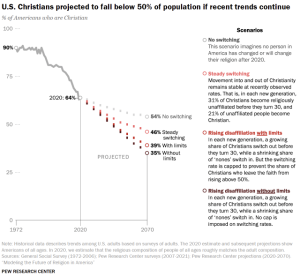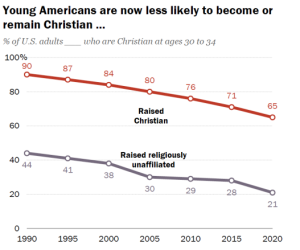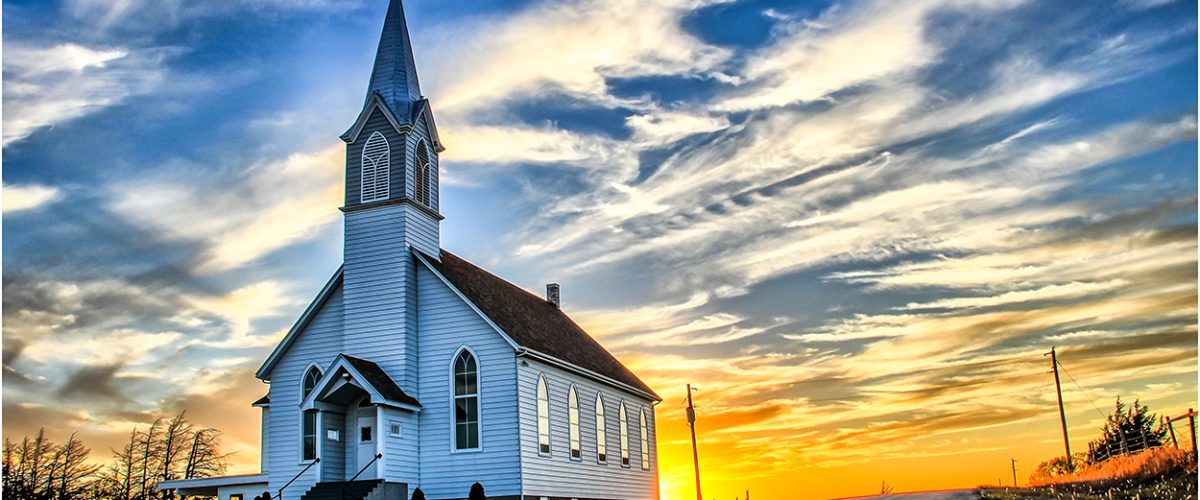If current trends continue, Christians will become a distinct minority in America and the “nones” will make up more than half the population by 2070.
“Nones” are those people who when asked their religious affiliation reply, “none,” although most are not atheist or agnostic.
These new findings came from Pew Research Center Sept. 14 in its latest reports on religion in America. In the worst case of four scenarios, by 2070 only 35% of Americans will identify as Christians while the “nones” will make up about 52% of the population, making them the new religious majority.
Pew offered four possibilities for the trending of religious affiliation: No switching, steady switching, rising disaffiliation with limits, and rising disaffiliation without limits.

In the “no switching” scenario, “no person in America has changes or will change their religion after 2020.” In the “steady switching” scenario, religious affiliation into and out of Christianity “remains stable at recently observed rates.” In the “rising disaffiliation with limits” scenario, a growing number of Christians disaffiliate from Christianity before they turn 30, while a shrinking number of people affiliate, but the rate of disaffiliation is capped at 50%. In the “rising disaffiliation without limits” scenario, the same thing occurs, but there is no limit on the rate of disaffiliation.
Currently, 64% of Americans affiliate with Christianity. In the “no switching” scenario, this number drops to 54% by 2070. In the “steady switching” scenario, it drops to 46%. For the “rising disaffiliation with limits” scenario, this number will drop to 39%, and without limits, 35%.
In these scenarios, Pew also accounts for the population of “nones” in America, people who are religiously unaffiliated. Currently, this group makes up 30% of Americans.
Pew projects that with no switching, the “nones” will make up 34% of Americans by 2070. In the steady switching scenario, they will make up 41%. In the rising disaffiliation with limits, the number rises to 48%, and without limits, to 52%.
In all four of these scenarios, Pew projects the number of “nones” in America will either “approach or exceed” the number of Christians by the year 2070.

In the no switching scenario, Christians would retain their majority through 2070. In the steady switching scenario, Christians would lose their majority, but still would be the largest religious group in America. In the rising disaffiliation with limits scenario, Christians would lose their majority status, and the nones would be the largest religious group in America, but neither group would be considered a majority. It is only in the rising disaffiliation without limits group wherein the nones would form a slim majority (52%).
According to Pew, the rising disaffiliation with limits scenario is the most plausible because it best illustrates “what would happen if recent generational trends in the U.S. continue.” This is the scenario that seems to mimic what has been observed around the world in recent years.
Additionally, the report addresses a couple of different generational possibilities for American Christians in the coming decades.
On the one hand, as levels of religious affiliation weaken from generation to generation, there will be a decline in levels of religious belief and practice among Americans in the next few generations as their parents and grandparents become less and less spiritual, and thus do not teach them to value religious practice.
On the other hand, “highly religious parents tend to raise highly religious children,” and those children tend not to disaffiliate during young adulthood. This maintains generations of highly religious people who are likely to raise their children to be highly religious, as their parents raised them.
Pew notes that none of the presented scenarios demonstrate what would happen if an increase in affiliations with Christianity occurred among Americans. They also do not consider dramatic events such as armed conflict, social movements, natural disasters or major religious revivals.
Instead, these projections are “limited to religious identity and do not project how religious beliefs and practices might change” in the future.
The “nones” in America “are not uniformly nonbelieving or nonpracticing,” as many who choose not to affiliate themselves with a religion still believe in or wonder about a higher power. So it is difficult to project what kinds of spiritual practices may take the place of institutional religious practice for these people in the coming decades.
Related articles:
Burge: Churches should brace for the downsizing still to come
These Christians are leaving behind the church, but not their faith


